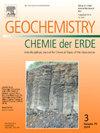Mineralogical, fluid inclusion, and stable isotope constraints on the genesis of Keban PbZn skarn deposit, southeast Anatolia
IF 2.9
3区 地球科学
Q2 GEOCHEMISTRY & GEOPHYSICS
引用次数: 0
Abstract
The Keban Pb![]() Zn deposit is located in the Elazığ district, southeastern Turkey and hosted by the Permo-Triassic/Permo-Carboniferous Keban Metamorphics and the Late Cretaceous-Paleocene Keban Magmatics. Mineralization develops as disseminated, veins and massive types of ore within alkali syenite porphyry, sericite-chlorite banded calc-schist and dolomitic limestone.
Zn deposit is located in the Elazığ district, southeastern Turkey and hosted by the Permo-Triassic/Permo-Carboniferous Keban Metamorphics and the Late Cretaceous-Paleocene Keban Magmatics. Mineralization develops as disseminated, veins and massive types of ore within alkali syenite porphyry, sericite-chlorite banded calc-schist and dolomitic limestone.
Three paragenetic stages of skarn formation and ore deposition are recognized in the Keban Pb![]() Zn deposit: prograde (stage I), retrograde-sulfide (stage II), and supergene (stage III). The endoskarn forming a narrow zone is composed of grossular (Grt 1), Fe-rich grossular (Grt 2) and andradite (Grt 3) with diopside and plagioclase. The exoskarn comprises grossular (Grt 4), pyroxene and vesuvianite. Ore minerals include galena, sphalerite, chalcopyrite, magnetite, hematite, molybdenite, and pyrite accompanied in small quantities by pyrrhotite, arsenopyrite, manganese oxides, native gold, and sulfosalts. Mineral chemistry of garnets suggests that Grt 1 precipitated under a low water/rock (W/R) ratio and relatively reduced conditions. Grt 2 with strong oscillatory zoning and Grt 3 with high Fe3+ contents were formed under infiltration metasomatism with high W/R ratios. When the water–rock intereaction was decreased, Grt 4 and vesuvianite were affected by Al-bearing residual metasomatic fluids that are derived from calc-schist under reduced conditions.
Zn deposit: prograde (stage I), retrograde-sulfide (stage II), and supergene (stage III). The endoskarn forming a narrow zone is composed of grossular (Grt 1), Fe-rich grossular (Grt 2) and andradite (Grt 3) with diopside and plagioclase. The exoskarn comprises grossular (Grt 4), pyroxene and vesuvianite. Ore minerals include galena, sphalerite, chalcopyrite, magnetite, hematite, molybdenite, and pyrite accompanied in small quantities by pyrrhotite, arsenopyrite, manganese oxides, native gold, and sulfosalts. Mineral chemistry of garnets suggests that Grt 1 precipitated under a low water/rock (W/R) ratio and relatively reduced conditions. Grt 2 with strong oscillatory zoning and Grt 3 with high Fe3+ contents were formed under infiltration metasomatism with high W/R ratios. When the water–rock intereaction was decreased, Grt 4 and vesuvianite were affected by Al-bearing residual metasomatic fluids that are derived from calc-schist under reduced conditions.
Depletion of δ13C and δ18O in skarn calcites is largely controlled by hydrothermal fluid infiltration and meteoric water influx. Microthermometric measurements support that magmatic fluids comprising the stage I (473 to 572 °C; 11.9 wt% NaCl eq.) were sequentially mixed with meteoric waters of stage II (230 to 524 °C; 0.8.-6.6 wt% NaCl eq). Based on FI trapping pressures and depths of the boiling system, the mineralization developed after boiling during the retrograde stage in a shallow environment characterized by low to moderate temperatures and low salinities, within the pressure and depth range of ∼100–500 bar and < 1.5 km, respectively. δ34S values of sulfide minerals are between −8.5 and + 2.1 ‰ indicating that ore-forming fluids and metals originated principally from a magmatic-hydrothermal source. High Fe, Mn and Ga contents of sphalerites might point to deposition at low to moderate temperature conditions and trace element concentrations imply that mineralization took place at distal part of the skarn system.
安纳托利亚东南部克班铅锌矽卡岩矿床成因的矿物学、流体包裹体和稳定同位素约束
克班铅锌矿床位于土耳其东南部Elazığ地区,受二叠纪-三叠纪/二叠纪-石炭系克班变质岩和晚白垩世-古新世克班岩浆作用。在碱正长斑岩、绢云母绿泥石带状钙片岩和白云质灰岩中,成矿发育为浸染状、脉状和块状矿石。克班铅锌矿床的矽卡岩形成与成矿共成阶段分为进积阶段(ⅰ期)、退积-硫化物阶段(ⅱ期)和表生阶段(ⅲ期)。内矽卡岩为狭长带,由粗长岩(Grt 1)、富铁粗长岩(Grt 2)和含透辉石和斜长石的顺长岩(Grt 3)组成。外矽卡岩由粗长岩(Grt 4)、辉石岩和维苏岩组成。矿石矿物包括方铅矿、闪锌矿、黄铜矿、磁铁矿、赤铁矿、辉钼矿和黄铁矿,少量伴有磁黄铁矿、毒砂、氧化锰、天然金和硫酸盐。石榴石矿物化学特征表明,Grt - 1是在低水岩比和相对还原条件下形成的。在高W/R的入渗交代作用下,形成了振荡带强的Grt 2和Fe3+含量高的Grt 3。当水岩相互作用减弱时,钙片岩在还原条件下衍生的含al残余交代流体对Grt 4和维苏岩的影响较大。矽卡岩方解石δ13C和δ18O的耗竭在很大程度上受热液渗透和大气水流入的控制。显微测温结果表明,第I阶段(473 ~ 572℃,11.9 wt% NaCl当量)的岩浆流体依次与第II阶段(230 ~ 524℃,0.8 ~ 6.6 wt% NaCl当量)的大气水混合。根据FI俘获压力和沸腾系统深度,在沸腾后的逆行阶段,矿化发生在低至中温、低盐度的浅层环境中,压力范围为~ 100-500 bar,深度范围为<; 1.5 km。硫化物矿物的δ34S值在−8.5 ~ + 2.1‰之间,表明成矿流体和成矿金属主要来源于岩浆-热液。闪锌矿铁、锰、镓含量高,表明成矿作用发生在中低温条件下;微量元素含量高,表明成矿作用发生在矽卡岩体系的远端。
本文章由计算机程序翻译,如有差异,请以英文原文为准。
求助全文
约1分钟内获得全文
求助全文
来源期刊

Chemie Der Erde-Geochemistry
地学-地球化学与地球物理
CiteScore
7.10
自引率
0.00%
发文量
40
审稿时长
3.0 months
期刊介绍:
GEOCHEMISTRY was founded as Chemie der Erde 1914 in Jena, and, hence, is one of the oldest journals for geochemistry-related topics.
GEOCHEMISTRY (formerly Chemie der Erde / Geochemistry) publishes original research papers, short communications, reviews of selected topics, and high-class invited review articles addressed at broad geosciences audience. Publications dealing with interdisciplinary questions are particularly welcome. Young scientists are especially encouraged to submit their work. Contributions will be published exclusively in English. The journal, through very personalized consultation and its worldwide distribution, offers entry into the world of international scientific communication, and promotes interdisciplinary discussion on chemical problems in a broad spectrum of geosciences.
The following topics are covered by the expertise of the members of the editorial board (see below):
-cosmochemistry, meteoritics-
igneous, metamorphic, and sedimentary petrology-
volcanology-
low & high temperature geochemistry-
experimental - theoretical - field related studies-
mineralogy - crystallography-
environmental geosciences-
archaeometry
 求助内容:
求助内容: 应助结果提醒方式:
应助结果提醒方式:


